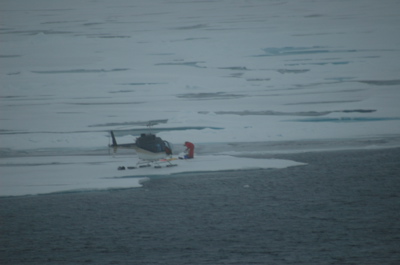( Log In ) Log In is for TREC Teachers & Researchers only
  |
| Steve_Stevenoski |
 Aug 18 2006, 03:43 AM Aug 18 2006, 03:43 AM
Post
#1
|
|
Member   Group: TREC Team Posts: 27 Joined: 19-July 06 Member No.: 39 |
August 14, 2006
Woke up at 3:00 am by mistake today. I had planned to get up at 6:00 because Harm said that there would be a flight briefing for deploying the instruments at about that time. Just my luck, the briefing was at 3:00 instead of 6:00 because we arrived at the start of our seismic refraction line earlier than expected. Helicopter Deploys Instruments  They flew out the first instrument at 3:30. They positioned it on a flow less than a half-mile from the ship. The weather was miserable. It was cold and rainy, but the visibility was good enough to fly. Once the helicopter landed, Anatoly and Harm set the instruments up on the flow. Once they put up the marker flag, you could see it was stretched flat in the stiff breeze. They would deploy one instrument at a time for most of the morning. Chase and Anatoly would make most of the morning flights by noon they had six instruments on the ice. Each pilot can fly up to 8 hours each day. Joseph started the day so by noon his flight hours were used up. Bill took over flying for the rest of the afternoon. There were 8 instruments to deploy before the end of the day. Matt and Russell would participate in the afternoon flight briefing and would work with Anatoly to set up the instruments. It would be until 6:00 before all 8 of the instruments had been positioned on the ice. The seismic refraction line would b e complete and flight ops would be done for the day. Once all the instruments were in place, we set a new course for the starting point at which we would deploy the seismic cage. While all the flying was going on, Larry Phillips spent most of the day looking at samples from various cores that he and the coring crew had taken over the last number of days. He was looking at the microscopic fossils of aquatic creatures called foraminifera. By looking at the types of fossils present he can give an approximate age of the sediments in which the fossils have been found. He can do so because he has worked with other cores from the Arctic Ocean and has had those cores dated using chemical and radiological methods. He will not be certain of the age of the samples until these cores are tested, but his best estimate is that they are about 90 million years old. Birds  We spent a good portion of the afternoon between flight ops out on the fantail unrolling a spare seismic streamer. The streamer that we had been using earlier in the cruise was either damaged to start, or damaged beyond repair while we were using it early in the cruise. The new streamer is over 300 meters long. Dale and Russell unrolled it off of a large wooden spool it was stored on in the seismic container. I helped Mark to lay it out on deck into a 30 foot to figure eight pattern so that it could be attached to the leader and put on the hydraulic drum for use later in the cruise. Birds Looking for Food  It took us about 3 hours to get the steamer on the drum. The rest of the evening was spent helping with watch and making sure that the cage and guns were ready to go. At dinner, Harm thought that we would be ready to deploy the guns at about 10:00. It would take us about 5 to 6 hours to reach the starting point of our new seismic refraction line. At 10:00 we were close to the starting point. A safety brief was conducted at 11:20. By 11:30 we were on deck preparing to deploy the cage. If everything worked properly it would take about two days to finish this line and then begin recollecting the instruments from the ice. |
  |
2 User(s) are reading this topic (2 Guests and 0 Anonymous Users)
0 Members:

|
NSF Acknowledgment & Disclaimer | Time is now: 31st October 2024 - 05:25 PM |
Invision Power Board
v2.1.7 © 2024 IPS, Inc.








